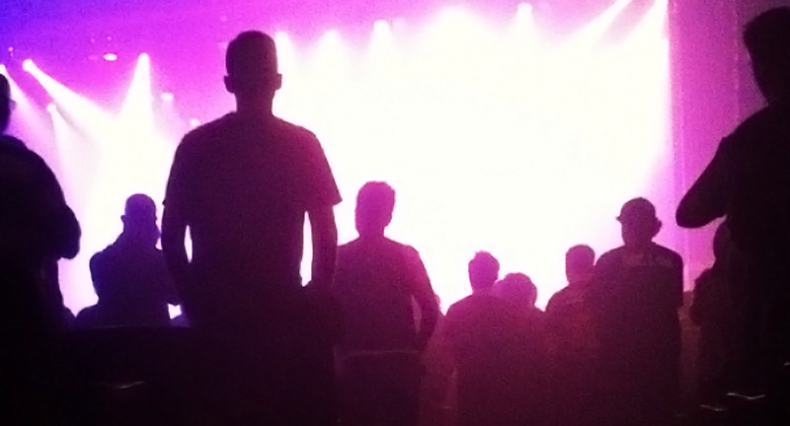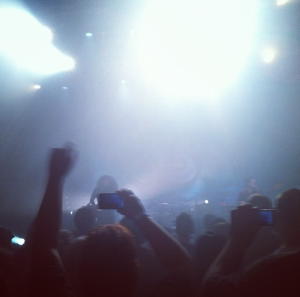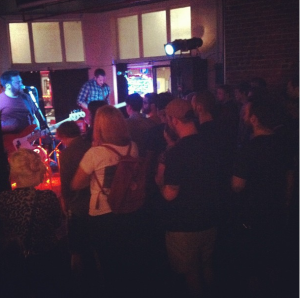How Musicians Create Value Around Performance in the Digital Age – Part 1: Dynamics

Previously, we explored “Everything You Need to Know About Band Management“, a primer on viewing creativity through the lens of the entrepreneur. The goal: to ensure you play lots of music for lots of people for lots of your life. We also talked about how the value around music is shifting from the song to the fan-artist relationship.
We’re tackling performance next because it’s the most direct way to experience this relationship, and it’s where most musicians start — before we are writing songs or recording, we’re playing in front of people.
Music comes alive through performance. This 8-part series will explore how musicians can generate value around performance in order to life a long, fulfilling musical life. We give particular attention to the changes happening in the music business, and how the ancient tradition of performance has transformed in the digital age.
Part 1: Dynamics takes you through the origin of music to the present day to define what performance is, and how the value emerges from the dynamic between musician, song, and listener.
All Music is Performance
Music is performance. How easily we forget recordings are merely copies of performances. And the composition itself has no meaning or value until performed. Performance is where music begins.
The origin of music is a fascinating subject, however time permits us only to scratch the surface here.
Suffice to say the origin of music is in performance. Music was synonymous with performance for over a million years. Music was not a distinct activity, but rather part of a mashup of primitive speech, gesture and mimicry. Over time, these untwined to be individual creative art forms as well as methods for practical communication.
In the past, geography limited the circulation of creative ideas, and distinct cultures grew with their own traditions of creativity. The only way to share information for most of human history was peer-to-peer, in person.
The digital age brings with it a globally connected world where culture is shared among all humans at an accelerating speed. As we’ve noted in the past, this has meant access to recordings is approaching free, and what is being devalued by technology is not music itself but rather copyright. It is impossible to devalue music because music is priceless. And it is possible to create new value around the artist-fan relationship because that is the “operating system” on which musicians build the value of their music.
Until Pythagoras set the stage for songwriting by beginning to unravel the science behind music, composition was a primitive oral tradition passed down generation to generation. There weren’t individual composers so much as the “author” was the culture and authorship was attributed to a people and a tradition.
Not until the onset of the Renaissance and subsequent Romantic period did our sense of authorship shift dramatically to the individual musical genius. In large part this was due to the technology of the time. The popularization of the printing press came around the same time as standard music notation, equal temperament and advances in piano and organ manufacturing. This pre-industrial age boom established the notion of intellectual property — using law to protect sheet music from being copied and devalued, and to productize the composition and artificially imbue it with value. Only in the last few centuries have humans regarded musicians as individual authors.
Don’t take for granted that music was performance until about 150 years ago, when the song recording became popular. It’s worth meditating on, so I’ll repeat: music has been synonymous with song recordings for only a few generations.
The main takeaways from the origin of music as it relates to understanding how to monetize performance in the digital age:

• All music is performance, in the sense that compositions and recordings only exist because of performances.
• Because all music is performance, the quality of your compositions and recordings is determined in large part by your ability to perform, or your ability to get others to perform your music (or like more and more musicians are doing, get a computer to perform your songs… pretty soon they’ll be composing and recording, too!)
• Understand that music authorship has a collective component. Your compositions and recordings are really just representations of performances in a given tradition. Today, we aren’t limited by geography. We call our musical traditions “genres” and they are just as tribal. While we’re encouraged to think of ourselves as individual geniuses, often it pays to understand your role as a tribal leader — the person who’s making the tradition relevant and powerful again by putting your heart and soul into it.
Difference Between Performance and Concerts
A quick distinction between performance and concerts before we move on: Playing concerts and shows is certainly the way most musicians think of performance. The concert industry is the only segment of the music business showing robust growth. Most of this series will deal with live performances at music venues.
But there’s a reason to make the separation between performances and concerts clear. Every day, there are more opportunities to perform for fans outside of music venues. For example, Concerts in Your Home puts on hundreds of concerts a year, where music fans host other fans who crowdfund a guarantee for an artist to come play their living room. There are digital services like Tunezy which allow musicians to follow the lucrative webcam business model and perform in front of their laptops while interacting with fans in exchange for gratuity.
The point is, performance is no longer relegated to physical music venue spaces. Increasingly, musicians are monetizing their performances online. It’s a way to provide an exclusive, interactive experience in an age of selling copies and passive consumer behavior. Toward the end of the series, we’ll be talking about ways you can both monetize your real-world performances with online fan inclusivity, and how you can create value online in your underwear at four in the afternoon using an iPad.
That said, most of this series will be about performance in the “traditional” sense of playing in a music venue for a live audience.
So, Where is the Value in Performance?

The value in performance is in the dynamic between musician, song, and listener.
The word “dynamic” here is so perfect, because all of its possible definitions apply to musical performance.
Of course, there is the musical definition of “dynamic” which relates to the volume and character of the music being played. The non-musical adjective form means “a process or system characterized by constant change, activity or progress.” And the noun form is “a force that stimulates change or progress within a system or process.”
Tossing the dictionary aside, we’ve all felt that magical feeling after an incredible concert. You leave the venue in awe, and feel like you’re trying to carry away the experience, relive it in your mind and store it to access for later. You can bet the musician nailed the dynamic.
Musicians rehearse so that each performance can be as consistent as the next. Even when there is improvisation, usually there’s lots of technique rehearsal behind it.
And yet, any musician will tell you that each different audience impacts the performance profoundly. A record label showcase, open mic night, music festival and school dance all have wildly different audience dynamics, and those dynamics will certainly be reflected in the performance.
My use of “dynamic” refers to the relationship between listener and musician, mediated and defined by the song being performed, at that moment in time.
As we’ve said before, music is not a thing but an experience, something people do. It exists in the moment, and then it is gone. A recording can be rewound, fast-forwarded. A composition can be rehearsed, repeated. A performance — and all of music, really — is a one-way trip that is born from and vanishes in silence.
Your focus when it comes to performance and creating both artistic and business value should be to focus on the dynamic created in the moment.
Performance is the most artistic, creative and subjective of the four musical life skills. Compositions can be interpreted, but they do not change. There is a mathematical certainty to musical notation. Recordings are set in stone. They can be mashed up and remixed, but until artists start releasing multitrack recordings and letting fans remix and master records as they see fit, the recording’s dynamic is limited to its playback system. Admittedly, the playback device can have enormous impact on the listener-song dynamic, but in an artificial way.
Performance, however, lives and dies on the dynamic. It by necessity is always changing and progressing toward its ending. The audience is changing the performance in real time as they react. The musician is changing the performance in real time as they react. A feedback loop is created, and inside this loop lies the dynamic.
It may sound abstract now, but the dynamic is responsible for creating the value from performances. It’s kind of a chain reaction. The dynamic determines how many people show up, where you can play, how much you get paid and how much merch you sell, so it’s very useful to look at creating value from performance through that lens.
Performance Skills
This series explores the ways in which musicians perform songs to create a dynamic between themselves and their audience. First, we’ll look at the performance skills it takes to create a great show:
• Part 2 – Execution is about how to prepare for a show, pull it off on stage, and learn from the experience to improve. This is what fans will remember.
• Part 3 – Sound is about how to strategically dial in the musical equipment of the band and venue to create the best dynamic. This is overlooked by way too many musicians who are just starting to play out.
Then, we’ll look at how to actually set up the performances:
• Part 4 – Booking lays forth a step-by-step strategy for growing your booking opportunities into bigger venues with bigger audiences. Booking is the key to earning money from live performance yet many musicians are ignorant to the complexities. Knowing the best practices will give you a huge edge.
• Part 5 – Promoting is more and more on the shoulders of the bands themselves, especially at the lower levels of the music business. Some of that’s justified, and some of it’s venues, booking agents and promoters exploiting musicians. Whether you’re expected to promote the show or not, promotion is the key to a show being successful, and is the only aspect of performance not directly tied to the dynamic you create. After all, people buy tickets before the show, not after. Nonetheless, promotion is actually part of the dynamic you create for the show, it sets up the performance and is critical to a great one.
• Part 6 – Touring is a sweeping overview of the many ins and outs of a regional, national or international tour. Touring is characterized by extremes. Extreme distances, emotions and sacrifices will beset you. Then again, extreme inspiration, fun and fulfillment can make for precious memories, meaningful connections and a growing fan base that will help support and sustain your dream of a musical life. We’ll focus on helping you navigate the extremes.
Musicians who are touring regularly enter another echelon of musicianship. That’s what Part 7 is all about.
• Part 7 – Lifestyle looks at the issues around choosing to tour frequently. Many musicians who decide to become professionals and make their living for music find themselves on the road for much of their lives. This has an enormous impact of the lifestyle they lead. We look at the wide-ranging issues of deciding to become a professional touring musician.
Finally, our series on performance will wrap up with a part about the present and future of performance as it lives online:
• Part 8 – Telepresence is about the growing trend of fans watching concerts on home computers or mobile devices. We look at new opportunities for musicians to monetize their performances or fan interaction online, including services that allow you to do this right now.
See you here tomorrow for Part 2 – Execution!

















Hi there!
Many thanks for this… Really interesting!
All best wishes, Flora